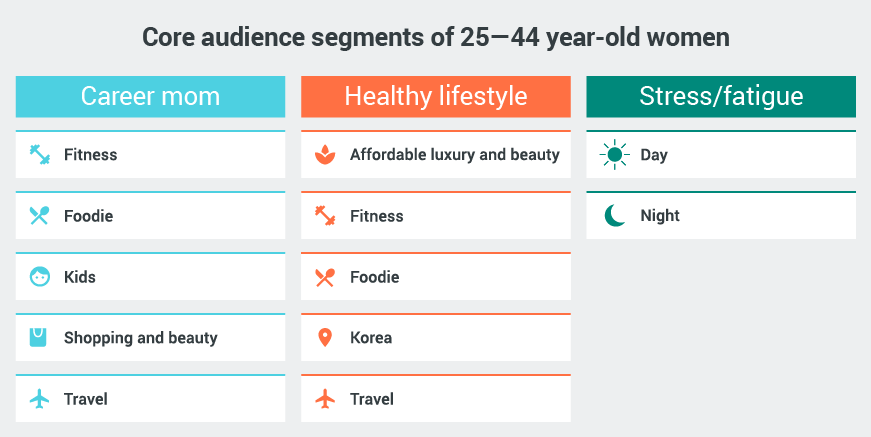Vichy—a premium skincare brand under the L’Oreal umbrella—wanted to reposition itself to its core audience of women in Hong Kong as the ideal beauty brand for promoting healthy skin. To reach three key audiences with unique messaging and boost overall awareness and consideration of the brand, Vichy turned to Google’s Vogon tool (*editor's update: in Sep 2017, we relaunched Vogon as Director Mix) to combine refined audience data with the power of machine learning technology.
GOALS
Boost awareness and drive overall consideration of the Vichy brand
Reach core audiences with compelling video ad creatives
APPROACH
Developed 12 unique video ad creatives to run on YouTube
Identified three audience segments and 12 sub-segments based on different interests, purchase intent, and online behaviors
Used Vogon to build each video creative’s call-to-action for the right audience
Measured and drove brand impact using Brand Lift surveys and in-store sales
RESULTS
37% increase in sales compared to previous campaigns—Vichy Mineral 89 became the #1 selling product for the brand in less than four weeks
33% increase in ad recall and nearly 40% increase in brand consideration
Achieved a 21% view-through rate and drove 640K views across 12 video creatives
16% decrease in cost-per-acquisition (CPA) compared to previous benchmarks
The Challenge: Segmenting audiences at scale
In the past, premium skincare brand Vichy relied on repurposing its TV spots to run on YouTube to promote its range of products. But over time, the brand realized that showing the same ad creative to a wide audience wasn’t helping them cut through the clutter of competition and build a strong presence. To reach its most valuable customers, Vichy set its sights on connecting with three core audiences: career moms, health and fitness lovers, and women suffering from stressed and fatigued skin.
Faced with a brand positioning challenge while following L’Oreal’s move into precision marketing, Vichy decided to move away from its previous strategy and focus on reaching its most engaged audiences through data-driven insights.
The Approach: Turning attention into action
To speak to the unique needs of 25–44-year-old women, Vichy knew it needed to find a way to quickly and easily serve personalized creatives to each audience. The brand started by using Google’s Real-Time Insights Finder to identify three of the brand’s most valuable audiences and then broke down 12 sub-segments based on each group’s unique interests and purchase intent:

After segmenting its audiences, Vichy launched a three-month video campaign using YouTube’s affinity audiences and Google’s Vogon tool. Along with targeting each audience by their video content consumption and browsing/search patterns, the brand used signals from millions of search queries as well as in-market audiences to reach users based on their different interests and passion points.
YouTube allowed us to more easily bridge the gap between our audiences’ online-to-offline shopping habits and maximize business result
Together with L’Oreal’s media agency, Mindshare, and teams at Google, Vichy came up with a campaign to promote one of its new products—Vichy Mineral 89—featuring 12 customized video ads that appealed to each unique audience segment. The brand used Vogon to dynamically populate each ad creative with different calls-to-action and ad messaging based on which audience was watching the ads and what they were searching for on YouTube.
“One of our main goals was to move away from running traditional TV commercials online and create more relevant and compelling campaigns using the latest digital technologies,” said Diana Ho, L’Oreal’s marketing director in the brand’s active cosmetics division. “YouTube allowed us to more easily bridge the gap between our audiences’ online-to-offline shopping habits and maximize business results.”
For example, career moms who were frequent fliers and had to spend a lot of time travelling were shown a 20-second custom ad (below) that said, “Travel makes your skin dry. Make sure to bring Mineral 89 along with you.”
Along with targeting affinity audience segments, Vichy also used daily weather data to inform its ad messaging and deliver videos calling out “sun damage” and the benefits of using their product on a sunny day. Even when the sun went down, the brand took the same approach to reach busy executives when they were working in front of a laptop or mobile screen during late office hours.
In another example, busy career women who were working late into the night were shown an ad (below) with the message, “Working overtime is not a problem! Mineral 89 keeps your skin healthy.”
“Each customized opening sequence allowed us to address the concerns of our consumers while tying them directly to our brand proposition in the first five seconds of our ads,” said Raymond Ng, digital and CRM manager in L’Oreal Hong Kong’s active cosmetics division. “Frequent travelers saw a message showing how they could beat dry skin with our product. Those who spent a lot of time outdoors under UV rays could keep their skin safe and protected. Each segment received a customized message that was sure to resonate with their interests and the unique challenges they were facing.”
The Result: Customized messaging leads Vichy to glowing success
In the span of just four weeks, the 12 YouTube ads saw a total of 640,000 total views at a 21% view-through rate. The campaign also achieved a 20X times higher conversion rate than other L’Oreal campaigns that ran at the same time. Most notably, the brand not only drove a 16% reduction in cost-per view but also a 3X reduction in CPA for online-to-offline purchases compared to the brand’s benchmarks—nearly 11,000 in-store samples were redeemed during the campaign.

Vichy also used YouTube’s Brand Lift surveys to measure the video ads’ impact on its core audience segments. The results were impressive: a 33% lift in ad recall and uplift in brand consideration of nearly 40%, which showed Vichy’s messaging was resonating among women in a category cluttered with competing beauty brands.
Overall, the campaign helped drive 37% higher sales than any of L’Oreal’s previous campaigns, and Mineral 89 took the #1 spot in the brand’s product line.






